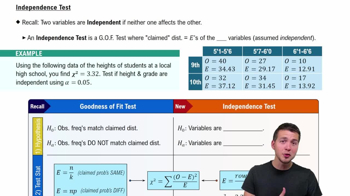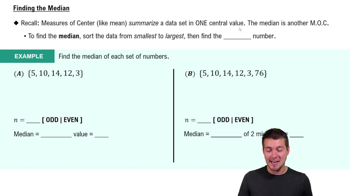Runs Test Assume that we use the runs test of randomness above and below the mean for the annual gross revenue of Amazon.com, Inc. each year for the past 25 years. If the number of runs is what do we know about Amazon.com?
Table of contents
- 1. Intro to Stats and Collecting Data1h 14m
- 2. Describing Data with Tables and Graphs1h 55m
- 3. Describing Data Numerically2h 5m
- 4. Probability2h 16m
- 5. Binomial Distribution & Discrete Random Variables3h 6m
- 6. Normal Distribution and Continuous Random Variables2h 11m
- 7. Sampling Distributions & Confidence Intervals: Mean3h 23m
- Sampling Distribution of the Sample Mean and Central Limit Theorem19m
- Distribution of Sample Mean - Excel23m
- Introduction to Confidence Intervals15m
- Confidence Intervals for Population Mean1h 18m
- Determining the Minimum Sample Size Required12m
- Finding Probabilities and T Critical Values - Excel28m
- Confidence Intervals for Population Means - Excel25m
- 8. Sampling Distributions & Confidence Intervals: Proportion1h 12m
- 9. Hypothesis Testing for One Sample3h 29m
- 10. Hypothesis Testing for Two Samples4h 50m
- Two Proportions1h 13m
- Two Proportions Hypothesis Test - Excel28m
- Two Means - Unknown, Unequal Variance1h 3m
- Two Means - Unknown Variances Hypothesis Test - Excel12m
- Two Means - Unknown, Equal Variance15m
- Two Means - Unknown, Equal Variances Hypothesis Test - Excel9m
- Two Means - Known Variance12m
- Two Means - Sigma Known Hypothesis Test - Excel21m
- Two Means - Matched Pairs (Dependent Samples)42m
- Matched Pairs Hypothesis Test - Excel12m
- 11. Correlation1h 6m
- 12. Regression1h 50m
- 13. Chi-Square Tests & Goodness of Fit1h 57m
- 14. ANOVA1h 57m
9. Hypothesis Testing for One Sample
Steps in Hypothesis Testing
Problem 13.CRE.4
Textbook Question
In Exercises 1–10, use the following weights (g) of Hershey’s Kisses from Data Set 38 “Candies” in Appendix B.

Sign Test Repeat Exercise 3 using the sign test to test the claim that the sample of weights is from a population with a median of 4.5333 g.
 Verified step by step guidance
Verified step by step guidance1
Step 1: Understand the sign test. The sign test is a non-parametric test used to determine whether the median of a sample differs from a specified value. It involves comparing each data point to the hypothesized median and recording whether the data point is above, below, or equal to the median.
Step 2: Compare each weight in the sample to the hypothesized median of 4.5333 g. For each weight, determine whether it is greater than, less than, or equal to the median. Record the signs (+ for greater, - for less, and 0 for equal).
Step 3: Count the number of positive signs (+), negative signs (-), and zeros (0). The zeros are excluded from the test, as they do not contribute to the comparison.
Step 4: Use the binomial distribution to calculate the probability of observing the given number of positive or negative signs under the null hypothesis that the population median is 4.5333 g. The null hypothesis assumes that the weights are equally likely to be above or below the median.
Step 5: Compare the calculated probability (p-value) to the significance level (e.g., 0.05). If the p-value is less than the significance level, reject the null hypothesis and conclude that the sample median differs from 4.5333 g. Otherwise, fail to reject the null hypothesis.
 Verified video answer for a similar problem:
Verified video answer for a similar problem:This video solution was recommended by our tutors as helpful for the problem above
Video duration:
2mPlay a video:
Was this helpful?
Key Concepts
Here are the essential concepts you must grasp in order to answer the question correctly.
Sign Test
The sign test is a non-parametric statistical method used to determine if there is a significant difference between the median of a sample and a specified value. It involves comparing each observation to the hypothesized median and counting the number of positive and negative differences. This test is particularly useful when the sample size is small or when the data does not meet the assumptions required for parametric tests.
Recommended video:
Guided course

Independence Test
Median
The median is a measure of central tendency that represents the middle value of a dataset when it is ordered from least to greatest. In cases where the dataset has an even number of observations, the median is calculated as the average of the two middle values. The median is less affected by outliers and skewed data compared to the mean, making it a robust measure for understanding the typical value in a dataset.
Recommended video:
Guided course

Calculating the Median
Hypothesis Testing
Hypothesis testing is a statistical procedure used to make inferences about a population based on sample data. It involves formulating a null hypothesis (H0) and an alternative hypothesis (H1), then using sample data to determine whether to reject the null hypothesis. The outcome is assessed using a significance level, which indicates the probability of making a Type I error, or incorrectly rejecting the null hypothesis when it is true.
Recommended video:
Guided course

Step 1: Write Hypotheses

 6:21m
6:21mWatch next
Master Step 1: Write Hypotheses with a bite sized video explanation from Patrick
Start learningRelated Videos
Related Practice
Textbook Question
